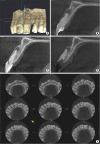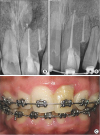1. Miles AE. Malformations of the teeth. Proc R Soc Med. 1954; 47:817–826.

2. De Jonge TE. Geminate tooth formation: schizodontia and synodontia, abstracted. Dent Abstr. 1957; 2:41.
3. Rani A K, Metgud S, Yakub SS, Pai U, Toshniwal NG, Bawaskar N. Endodontic and esthetic management of maxillary lateral incisor fused to a supernumerary tooth associated with a talon cusp by using spiral computed tomography as a diagnostic aid: a case report. J Endod. 2010; 36:345–349.

4. Hagman FT. Anomalies of form and number, fused primary teeth, a correlation of the dentitions. ASDC J Dent Child. 1988; 55:359–361.
5. Kayalibay H, Uzamis M, Akalin A. The treatment of a fusion between the maxillary central incisor and supernumerary tooth: report of a case. J Clin Pediatr Dent. 1996; 20:237–240.
6. Velasco LF, de Araujo FB, Ferreira ES, Velasco LE. Esthetic and functional treatment of a fused permanent tooth: a case report. Quintessence Int. 1997; 28:677–680.
7. Cho KM, Jang JH, Park SH. Clinical management of a fused upper premolar with supernumerary tooth: a case report. Restor Dent Endod. 2014; 39:319–323.

8. Mazumdar P, Das UK, Rahaman SM. Endodontic management of geminated tooth: a case report. Int J Sci Res Public. 2013; 3:1–4.
9. Mader CL. Fusion of teeth. J Am Dent Assoc. 1979; 98:62–64.

10. Lowell RJ, Solomon AL. Fused Teeth. J Am Dent Assoc. 1964; 68:762.
11. Hülsmann M, Bahr R, Grohmann U. Hemisection and vital treatment of a fused tooth--literature review and case report. Endod Dent Traumatol. 1997; 13:253–258.
12. Kurihara Y. Studies on the teeth from thalidomide baby. Jpn J Pediatr Dent. 1963; 1:68–74.
13. Knudsen PA. Fusion of upper incisors at bud or cap stage in mouse embryos with exencephaly induced by hypervitaminosis A. Acta Odontol Scand. 1965; 23:549–565.

14. Scerri E, Gatt G, Camilleri S, Mupparapu M. Morphologic and developmental disturbances of permanent teeth following trauma to primary dentition in a selected group of Maltese children. Quintessence Int. 2010; 41:717–724.
15. Hattab FN. Double talon cusps on supernumerary tooth fused to maxillary central incisor: review of literature and report of case. J Clin Exp Dent. 2014; 6:e400–e407.

16. Schuurs AH, van Loveren C. Double teeth: review of the literature. ASDC J Dent Child. 2000; 67:313–325.
17. Yuen SW, Chan JC, Wei SH. Double primary teeth and their relationship with the permanent successors: a radiographic study of 376 cases. Pediatr Dent. 1987; 9:42–48.
18. Maibaum WW. Fusion of confusion? Oral Surg Oral Med Oral Pathol. 1990; 69:656–657.
19. Sivolella S, Bressan E, Mirabal V, Stellini E, Berengo M. Extraoral endodontic treatment, odontotomy and intentional replantation of a double maxillary lateral permanent incisor: case report and 6-year follow-up. Int Endod J. 2008; 41:538–546.

20. Nunes E, de Moraes IG, de Novaes PM, de Sousa SM. Bilateral fusion of mandibular second molars with supernumerary teeth: case report. Braz Dent J. 2002; 13:137–141.

21. Kim E, Jou YT. A supernumerary tooth fused to the facial surface of a maxillary permanent central incisor: case report. J Endod. 2000; 26:45–48.

22. Krishnamurthy M, Kumar VN, Leburu A, Jeddy N. Fusion of maxillary central incisors with mesiodens. J Oral Maxillofac Pathol. 2018; 22:S131–S134.

23. Kim SY, Choi SC, Chung YJ. Management of the fused permanent upper lateral incisor: a case report. Oral Surg Oral Med Oral Pathol Oral Radiol Endod. 2011; 111:649–652.

24. Sammartino G, Cerone V, Gasparro R, Riccitiello F, Trosino O. Multidisciplinary approach to fused maxillary central incisors: a case report. J Med Case Reports. 2014; 8:398.

25. Aydemir S, Ozel E, Arukaslan G, Tekce N. Clinical management of a fused mandibular lateral incisor with supernumerary tooth: a case report. Dent Res J (Isfahan). 2016; 13:80–84.

26. Samimi P, Shirban MR, Arbabzadeh-Zavareh F. Non-invasive management of fused upper incisors. Dent Res J (Isfahan). 2012; 9:107–110.

27. Kalender WA, Seissler W, Klotz E, Vock P. Spiral volumetric CT with single-breath-hold technique, continuous transport, and continuous scanner rotation. Radiology. 1990; 176:181–183.

28. Patel S, Dawood A, Ford TP, Whaites E. The potential applications of cone beam computed tomography in the management of endodontic problems. Int Endod J. 2007; 40:818–830.

29. Ludlow JB, Davies-Ludlow LE, Brooks SL, Howerton WB. Dosimetry of 3 CBCT devices for oral and maxillofacial radiology: CB Mercuray, NewTom 3G and i-CAT. Dentomaxillofac Radiol. 2006; 35:219–226.

30. Badole GP, Warhadpande MM, Shenoi PR, Lachure C, Badole SG. A rare root canal configuration of bilateral maxillary first molar with 7 root canals diagnosed using cone-beam computed tomographic scanning: a case report. J Endod. 2014; 40:296–301.

31. Björn H. Experimental studies on reattachment. Dent Pract Dent Rec. 1961; 11:351.
32. Helsham RW. Some observations of the subject of roots of teeth retained in the jaws as a result of incomplete exodontia. Aust Dent J. 1960; 5:70–77.

33. Rodd HD, Davidson LE, Livesey S, Cooke ME. Survival of intentionally retained permanent incisor roots following crown root fractures in children. Dent Traumatol. 2002; 18:92–97.

34. Choi S, Yeo IS, Kim SH, Lee JB, Cheong CW, Han JS. A root submergence technique for pontic site development in fixed dental prostheses in the maxillary anterior esthetic zone. J Periodontal Implant Sci. 2015; 45:152–155.

35. Reames RL, Nickel JS, Patterson SS, Boone M, el-Kafrawy AH. Clinical, radiographic, and histological study of endodontically treated retained roots to preserve alveolar bone. J Endod. 1975; 1:367–373.

36. Park JB, Lee JH. Use of mineral trioxide aggregate in the open apex of a maxillary first premolar. J Oral Sci. 2008; 50:355–358.

37. Badole GP, Warhadpande MM, Bahadure RN, Badole SG. Nonsurgical endodontic treatment of permanent maxillary incisors with immature apex and a large periapical lesion: a case report. Gen Dent. 2015; 63:58–60.
38. Huang GT. Apexification: the beginning of its end. Int Endod J. 2009; 42:855–866.

39. Regan JD, Gutmann JL, Witherspoon DE. Comparison of Diaket and MTA when used as root-end filling materials to support regeneration of the periradicular tissues. Int Endod J. 2002; 35:840–847.

40. Apaydin ES, Shabahang S, Torabinejad M. Hard-tissue healing after application of fresh or set MTA as root-end-filling material. J Endod. 2004; 30:21–24.








 PDF
PDF Citation
Citation Print
Print




 XML Download
XML Download